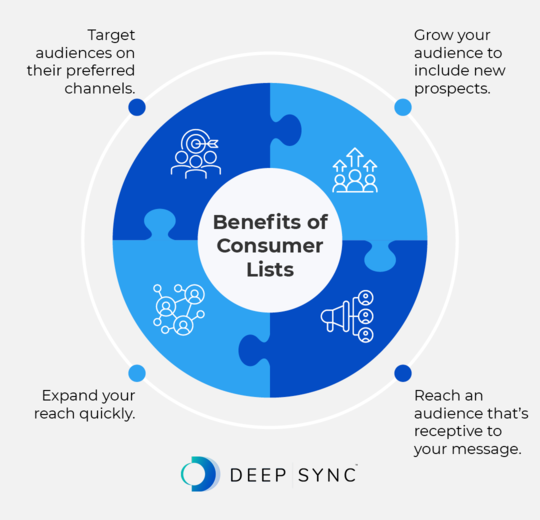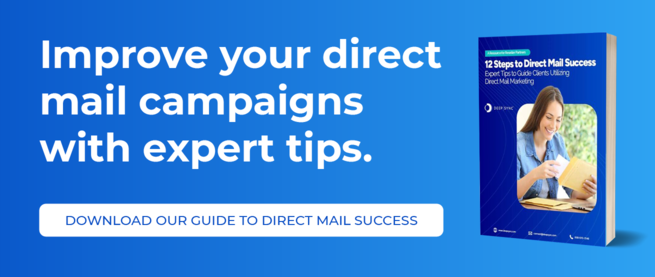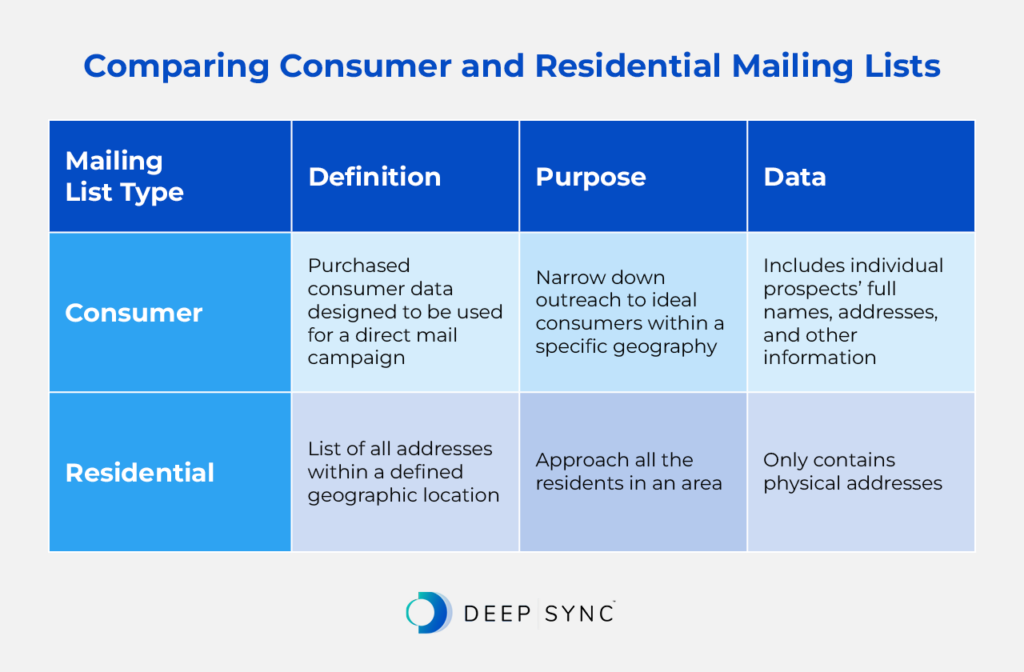When you hear “Consumer Lists,” the first thing that comes to mind is probably consumer mailing lists. However, consumer audiences have so many marketing uses beyond direct mail!
High-quality consumer data can fuel omnichannel marketing campaigns across online and offline channels. Or, you can use consumer marketing data to reach prospects on their preferred channels.
In this guide, we’ll review the benefits of using consumer marketing data to supplement your marketing efforts. We’ll cover:
- What Are Consumer Lists?
- Are Consumer Lists Safe for Businesses to Use?
- How Can I Buy Consumer Lists?
- What’s Included in a Consumer List?
- Tips for Using Consumer Lists Effectively
If used properly, consumer marketing data can be one of the most effective tools in your physical and digital marketing strategy. Let’s dive in!

What Are Consumer Lists?
A consumer list is a type of marketing list that includes the names and contact information of prospective customers. You can create consumer marketing audiences based on different attributes like demographics, new mover status, net worth, lifestyle, and interests. Today, with geo-mapping and other technologies, these lists can be made hyper-specific to your target market.
Some examples of niche consumer lists include:
- Gen Z consumers
- Individuals with a Health Services occupation
- Households with Children
- Household Incomes $250,000+
- Consumers Interested in Healthy Living
- Households with Veterans
Purchasing and using consumer marketing data allows you to elevate your targeting based on prospects’ behaviors, needs, and wants. While consumer mailing lists are one of the most common types of consumer marketing audiences, high-quality consumer data can be used to reach prospects in their mailboxes, inboxes, and on their favorite websites, apps, and streaming services.
Benefits of Consumer Lists
Perhaps, then, it’s no surprise that consumer marketing data can benefit your marketing strategy. With the aid of consumer lists, you can:

- Grow your audience to include new prospects. Leverage consumer data to broaden your audience to a new demographic or expand your reach into a new geographic area.
- Reach an audience that’s receptive to your message. By targeting niche groups of consumers, you’ll be able to reach out to likely-to-convert prospects with messages that resonate.
- Expand your reach quickly. Purchasing consumer data works faster than organically building an audience from scratch. Consumer lists let you hit the ground running immediately while still building up an organic audience.
- Target audiences on their preferred channels. When you use consumer data to target prospects by generation, you can increase your efforts on their preferred channels. While direct mail is especially effective for Millennials, 74% of Baby Boomers believe that email is the most personal channel to receive communications from brands. As for Gen Z marketing, consumer lists allow you to reach young adults above the age of 18 on their favorite devices.
Types of Consumer Lists
As previously mentioned, consumer lists can be used for mailing—but they can also be used to reach prospects in their email inboxes and on their favorite websites, apps, and streaming services.
What are consumer mailing lists?
A consumer mailing list is purchased consumer data that is designed to be used for a direct mail campaign. Unlike a Residential Mailing List (which only contains physical addresses), a consumer mailing list can include individual prospects’ full names, addresses, and other information. With this type of marketing list, you can send messages to specific people that you’re hoping to reach.

What are consumer mailing lists vs. Resident/Occupant Lists?
A resident/occupant list is a list of all addresses within a defined geographic location. Whether you know it or not, you’re likely familiar with this type of list. Mail addressed to “ Current Resident” (rather than a specific name) is generally sent from a resident/occupant list.
With Res/Occ lists, you can choose target areas based on a variety of factors, such as:
- Mail carrier route
- ZIP code, city, county, or state boundary
- Congressional district
- Driving time
- General radius
In contrast, rather than approaching all the residents in an area via a resident/occupant list, a consumer mailing list enables you to narrow down your outreach to your ideal consumers within a specific geography. In this sense, consumer data can offer your marketing team a more targeted, personalized approach to direct mail.

What are digital consumer audiences?
Digital consumer audiences include purchased consumer data designed to be used on online channels. Digital consumer audiences can be used for email, programmatic, CTV, social media, and other online marketing campaigns.
Are Consumer Lists Safe for Businesses to Use?
Let’s set the record straight: Yes, it’s legal and safe to purchase consumer marketing lists. However, it’s also important to be aware of the relevant regulations for both digital and direct mail lists, including CCPA, VCDPA, and CPA.
In addition to national regulations in the United States, new and evolving state legislation—such as the California Consumer Protection Act (CCPA), the Virginia Consumer Data Protection Act (VCDPA), and the Colorado Privacy Act (CPA)—also regulates how consumer data is bought and sold.
While it’s crucial to follow these regulations for all of your marketing campaigns, you should also ensure that any data provider you work with maintains regulatory compliance with state and national laws.
Deep Sync, for example, meets, if not exceeds, all applicable consumer privacy requirements. Opt-outs are accepted from every state and are universally applied as “Do Not Sell” requests. Additionally, Deep Sync maintains SOC 2 Type II compliance and follows all current Association of National Advertising (ANA) guidelines.
How Can I Buy Consumer Lists?
With an experienced provider, buying consumer lists can be quite easy, worry-free, and tailored to your business. Once you’re ready to begin the process, find a data partner (like Deep Sync!) that offers precise audience creation.
To avoid any potential complications, your consumer data provider should offer the necessary regulatory compliance. Additionally, the best providers will offer:
- Rigorous data vetting and approval processes.
- Easy access and 24/7 online list ordering.
- High deliverability rates with up-to-date, clean data.
- Customization and the ability to filter and cross-tabulate data to target precise consumer attributes.
Even if you already have a burgeoning customer base, you can use consumer lists to supplement your organic audience-building activities.
What’s Included in a Consumer List?
Not all consumer lists are made equally. Different marketing list providers offer different types and levels of information within their marketing lists. While some providers will offer only a limited set of lists, others offer a range of customization features.
For instance, Deep Sync’s consumer lists can be tailored based on the following criteria:
- Buying Activities
- Demographics
- Financial Data
- Lifestyles and Interests
- New Homeowner Status
- New Mover Status
- …and so much more.
But this is just the start! You can filter for multiple characteristics, from the presence of children or pets to religion—and everything in between.
With Deep Sync, your business also has access to exclusive turn-key GEO-Direct mapping tools to visualize your lists and the spatial relevance of your data. In consultation with our team of marketing and analytics experts, you’ll determine the relevant filters and develop your lists.
You can then leverage this clean, demographically targeted consumer data to reach the right prospects for your product or service and influence their purchasing. Instead of sending the same messaging to a wide range of consumers, you can customize your marketing materials to each audience segment’s interests and demographics.
Tips for Using Consumer Lists Effectively
Effectively using a consumer list is both an art and a science. So what can you do to make the most out of your lists?
Define your goals before choosing your consumer list.
Before purchasing a consumer list, consider your goals. This process may include answering questions like:
- What demographics are you hoping to target? Do you want consumers to live within a defined geographic area or fall within a certain age range? What insights into your current customers can help you inform which groups of consumers you should target?
- What are your goals? Are you hoping to boost conversions, clickthrough rates, discount code use, or something else entirely?
By defining your goals and only then choosing the appropriate list type, you can ensure that you’re reaching out to the most relevant audience possible. Best practices suggest that this will help generate the most targeted and impactful consumer lists.
Use A/B testing in your outreach.
If you’re trying to narrow down your ideal buyer persona, you might also use consumer lists to test the same campaign with different attributes such as income level, age group, or gender. Throughout these tests, watch your key performance indicators (KPIs) carefully to see how campaign metrics (such as response rates or conversion rates) are impacted by each change.
If you already have your ideal buyer persona well-defined, you can still use A/B testing in your outreach. As you begin to use your purchased consumer lists, test slightly different messaging to different segments to see which receives the most engagement.
If you decide to use A/B testing, it’s important to make incremental changes and alter only one element at a time. Making large-scale changes to a campaign will make it impossible to understand what exactly made the difference in your KPIs. As you see quantifiable improvements in audience engagement, continue to test different audience segments (such as A/B splits) to find the most impactful wording, format, and time of year to send your outreach messages.
Final Thoughts
With so many brands competing for attention, consumer lists can help your business reach new prospects. Reaching new audiences and knowing your customers better gives you a competitive advantage—allowing you to rise above the competition and stand out as the best option in the industry.
Ultimately, using consumer lists from Deep Sync allows you to market your business to a highly targeted audience, helping you avoid wasting your time and resources sending messages to disinterested consumers. In addition to consumer lists, Deep Sync offers several other marketing products and services, including:
- Resident/Occupant Lists
- Enhanced Occupant Lists
- New Mover Lists
- New Homeowner Lists
- New Construction Lists
- Business Lists
- Apartment Lists
- Student Marketing Lists
Regardless of what type of list you purchase, consider an omnichannel approach for your marketing campaigns. A planned combination of online and offline engagement can maximize your results.
For more information about the best strategies for purchasing and using consumer lists, review the following additional resources:
- Using Your Customer Data: Best Practices. Deep Sync’s guide to customer data can help you turn your database into your competitive advantage.
- Navigating Postal Rate Increases: Unlock Better ROI with Data. Despite postal rate increases, mail remains a valuable marketing channel. Get a better return on marketing spend with these best practices.
- Residential Mailing Lists: The Ultimate Guide. For more information, check out Deep Sync’s guide to residential mailing lists.













0 Comments